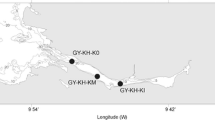Abstract
A microarray for the detection of toxic algal species was developed in the European Union 7th Framework project MIDTAL. We initially tested all available fluorescence in situ hybridisation probes for toxic algae, which are normally designed to a length of 18 nt, and found that in most cases the signal was rather weak or all probes designed from the second half of the molecule were inaccessible in a microarray format because of secondary structure of the ribosomal RNA molecule We modified the length of the probes, the fragmentation of the rRNA, the stringency of the washing buffers and the length of the spacer molecules linking the probes to the glass surface of the microarray. Because of the secondary structure of the rRNA molecule, regions of the molecule can be difficult to access by the probes. Each of these modifications has improved probe accessibility and probe specificity to reduce false positives.







Similar content being viewed by others
References
Kegel J, Amo Y, Medlin LK (2013) Introduction to project MIDTAL: its methods and samples from Arcachon Bay, France. Env. Poll Sci Res. doi: 10.1007/s11356-012-1299-9
Lewis J, Medlin LK, Raine R (2012) MIDTAL (Microarrays for the Detection of Toxic Algae): a protocol for a successful microarray hybridization and analysis. Koeltz, Germany
Metfies K, Medlin LK (2008) Feasibility of transferring FISH-probes to an 18S rRNA gene phylochip and a mapping of signal intensities. Appl Environ Microbiol 74:2814–2821
Acknowledgments
Jixin Chen performed all of the experiments presented here.
Author information
Authors and Affiliations
Corresponding author
Additional information
Responsible editor: Philippe Garrigues
Rights and permissions
About this article
Cite this article
Medlin, L.K. Note: steps taken to optimise probe specificity and signal intensity prior to field validation of the MIDTAL (Microarray for the Detection of Toxic Algae). Environ Sci Pollut Res 20, 6686–6689 (2013). https://doi.org/10.1007/s11356-012-1450-7
Received:
Accepted:
Published:
Issue Date:
DOI: https://doi.org/10.1007/s11356-012-1450-7



